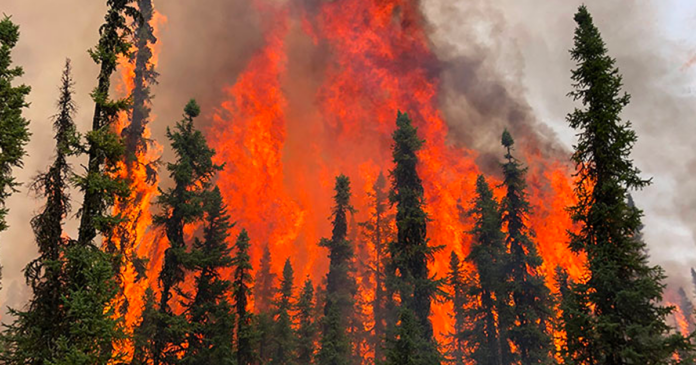Canada’s political leaders and the legacy media have used a particularly severe wildfire season to further their political climate change narrative contrary to the facts.
Prime Minister Justin Trudeau has repeatedly claimed that the wildfires raging across the country are caused by climate change.
“We’re seeing more and more of these fires because of climate change. We’ll keep working – here at home and with partners around the world – to tackle climate change and address its impacts,” tweeted Trudeau on June 7.
We’re seeing more and more of these fires because of climate change. These fires are affecting everyday routines, lives and livelihoods, and our air quality. We’ll keep working – here at home and with partners around the world – to tackle climate change and address its impacts.
— Justin Trudeau (@JustinTrudeau) June 7, 2023
Coalition partner and NDP leader Jagmeet Singh has also made the misleading claim that Canada has “never seen wildfires” like those currently raging and linking them to climate change.
“We’re seeing the clear trend in the face of what is clearly the result of a climate crisis which is exacerbating an existing problem,” said Singh.
Wildfires are engulfing communities. The smoke is poisoning the air we breathe.
— Jagmeet Singh (@theJagmeetSingh) June 9, 2023
We can’t deny climate change. We can’t talk about it and do nothing.
People’s lives, homes and futures are at risk — we have to act.
That’s what we’re demanding the government to do. pic.twitter.com/4tNQx4J22d
Liberal Environment Minister Steven Guilbeault also was quick to jump to conclusions in a statement on the wildfires.
“The threat of increased fires due to climate change is one of the many reasons our government is developing a robust national adaptation strategy with all levels of government and Indigenous groups, so we can be sure our communities are well prepared for the impacts of climate change,” said Guilbeault.
In reality, Canada has experienced several years where the area burned by forest fires was much larger including in 1989, 1994 and 1995.
“The period from 28 May until 7 July (1995) saw the largest mobilization of resources on record. Over 1000 fire management personnel had moved, including 520 personnel from the United States,” writes the Global Fire Monitoring Centre.
Similar claims were further perpetuated by the CBC and other legacy media outlets. Politico also spread Trudeau’s claim that climate change was the driver of the wildfire. US media outlets like the New Yorker and Bloomberg also furthered this narrative.
Even the federal government’s data says little to justify the apocalyptic narrative spread by the prime minister and others.
Data from the Canadian National Large Fire Database shows that the number of wildland fires has been decreasing over the past 40 years. The area burned by wildfires each year also does not show a clear enough trend to support the extraordinary claims about climate change.
Six of the worst years for wildfires occurred in the first half of the 40-year period and recent severe years show fewer hectares being burned when compared to before according to the total area of Canada burned.
Experts agree that wildfires are influenced by many factors, not just the climate. According to British Columbia government data, lightning and human activity cause a vast majority of fires.
In 40% of recorded cases, humans have caused wildfires as a result of activity such as open burning, vehicle use, industrial activity, fireworks or discarding burning items. Intentionally set fires due to arson can also be a cause like in the case of the 29 Okanagan fires from 2014 to 2018 that were discovered to be deliberately set by an RCMP taskforce.
According to a summary of the 2022 wildfire season in British Columbia, despite drought-like conditions and high temperature records, the province saw a “below normal” level of wildfires.
“Many areas of the province set temperature records, and accumulated rainfall amounts through September that were below normal levels. Despite the late drought conditions, the 2022 wildfire season remained below normal in terms of number of fires and area burned statistics,” the summary states.
Last year, British Columbia reported that 32% of the 1,801 fires the province had were human-caused, while 66% were found to have been caused by lightning.
The Canadian Wildland Fire Information System, which measures the dryness and temperature of the environment, indicates that this year’s conditions are not ideal, yet ignition has to factor in the amount and type of vegetation in the area and the preventative efforts of firefighters.
The west coast has also seen an accumulation of deadwood on forest floors, due to the suppression of natural fires that are part of the ecological cycle creating a tinderbox for potential spontaneous blazes.
A lack of funding and support for controlled burning and management could also be a major factor. According to a paper published by Mark Heathcott, a former head of Parks Canada for 20 years, controlled burning is necessary to reduce fuel loads and restore forest health.
“Wildfire management agencies in Canada are at a tipping point. Presuppression and suppression costs are increasing but program budgets are not,” wrote Heathcott.
Additionally, Heathcott has argued that Covid-19 pandemic responses and lockdowns have set Canada back in terms of being prepared to tangle with subsequent wildfire seasons.

